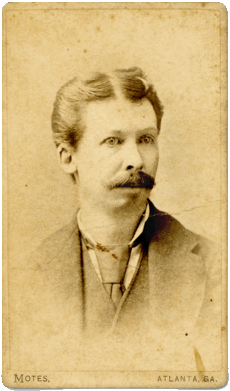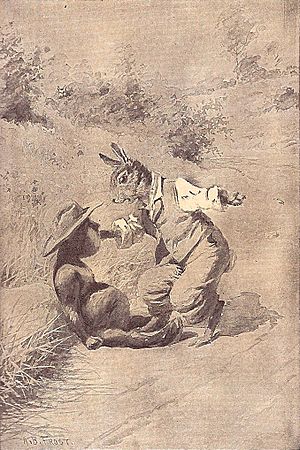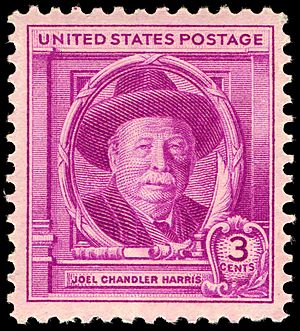Joel Chandler Harris facts for kids
Quick facts for kids
Joel Chandler Harris
|
|
|---|---|
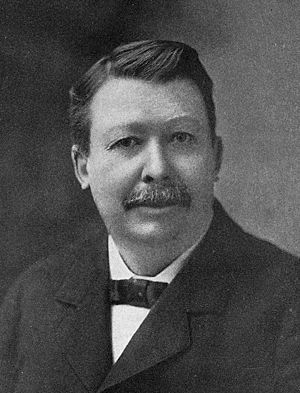 |
|
| Born | December 9, 1848 Eatonton, Georgia, United States |
| Died | July 3, 1908 (aged 59) Atlanta, Georgia, United States |
| Occupation | Journalist, fiction writer, folklorist |
| Notable works | Uncle Remus: His Songs and His Sayings Nights with Uncle Remus |
| Children | Julian LaRose Harris |
| Relatives | Julia Collier Harris (daughter-in-law) |
| Signature | |
 |
|
Joel Chandler Harris (born December 9, 1848 – died July 3, 1908) was an American journalist, writer, and folklorist. He is most famous for his collection of Uncle Remus stories. Harris was born in Eatonton, Georgia. As a teenager, he worked on a plantation. Later, he spent most of his adult life in Atlanta, working as an editor for The Atlanta Constitution newspaper.
Joel Chandler Harris had two main parts to his career. As a journalist, he worked with editor Henry W. Grady. They wanted to help the Southern states heal and unite after the American Civil War and the Reconstruction era. As a writer and folklorist, Joel Chandler Harris wrote many 'Brer Rabbit' stories. These stories came from the oral traditions of African Americans.
Contents
Joel Chandler Harris's Early Life
Growing Up in Georgia: 1848–1862
Joel Chandler Harris was born in Eatonton, Georgia, in 1848. His mother, Mary Ann Harris, was an Irish immigrant. Joel's father left the family soon after he was born. A kind doctor, Dr. Andrew Reid, gave Mary Harris and her son a small house. Mary worked hard as a seamstress and gardener to support them. She loved to read, and she taught Joel to love language too. He once said that hearing his mother read The Vicar of Wakefield made him want to write.
Dr. Reid also paid for Joel's school for a few years. Joel went to two different schools in Eatonton. He wasn't a great student and often skipped class. But he was very good at reading and writing. He was also known for his jokes and sense of humor. These jokes helped him hide his shyness.
Working at Turnwold Plantation: 1862–1866
When Joel was 14, he left school to find work. In March 1862, Joseph Addison Turner hired him. Turner owned Turnwold Plantation, and he had a newspaper called The Countryman. Joel worked as a printer's devil, which meant he helped with printing. He got clothes, a room, and food in return. The Countryman was a big newspaper in the South during the American Civil War.
Joel learned how to set type for the newspaper. Mr. Turner also let him publish his own poems, book reviews, and funny articles. Turner taught Joel a lot about writing and printing. Joel also read many books from Turner's large library. He read works by famous writers like Charles Dickens and William Shakespeare.
While at Turnwold Plantation, Joel spent a lot of time with the enslaved people. He felt comfortable with them because of his own humble background. He listened to their stories, their way of speaking, and their unique words. People like Uncle George Terrell, Old Harbert, and Aunt Crissy shared African-American animal tales with him. These stories later became the inspiration for Joel's famous Uncle Remus tales. George Terrell and Old Harbert especially inspired the character of Uncle Remus.
Journalism in the South: 1866–1876
The Countryman newspaper closed in May 1866. Joel Harris left the plantation with very little money or belongings. Later that year, The Macon Telegraph hired him as a typesetter. He didn't like this job much. After a few months, he moved to New Orleans for another job. But he soon missed Georgia and returned. He found a new opportunity at the Monroe Advertiser, a weekly newspaper in Forsyth, Georgia.
At the Advertiser, Joel wrote a popular column called "Affairs of Georgia." Other newspapers in the state often reprinted his funny articles and political jokes. Because of his growing reputation, he became an associate editor at the Savannah Morning News. This was the biggest newspaper in Georgia. He took the job, which paid much more, and quickly became known as Georgia's top humor writer.
In 1872, Joel met Mary Esther LaRose, a 17-year-old French-Canadian girl from Quebec. They got married in April 1873. Over the next three years, they had two children. Their life in Savannah changed suddenly when they had to move to Atlanta. They were trying to escape a yellow fever outbreak.
Life and Writing in Atlanta
Working at The Atlanta Constitution: 1876–1908
In 1876, Henry W. Grady hired Joel Harris to work at The Atlanta Constitution. Joel stayed there for 24 years. He supported the idea of racial peace that Grady believed in. Joel often took a trolley to work, picked up his assignments, and finished them at home. He wrote for the Constitution until 1900. He also wrote stories for popular magazines like Scribner's and Harper's.
The Uncle Remus Stories
Soon after starting at the newspaper, Joel began writing the Uncle Remus stories. He wanted to "preserve" these old tales. He felt they were important memories of a time that might be misunderstood later. The stories were printed in newspapers all over the United States. A publisher, D. Appleton and Company, asked him to put them into a book.
The book, Uncle Remus: His Songs and His Sayings, was published in late 1880. Many newspapers reviewed this best-selling book, and Joel became famous across the country.
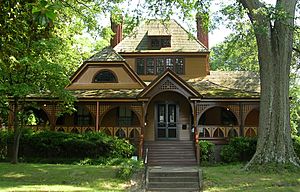
The money from the book allowed Joel to rent a house in West End, a small town outside Atlanta. This was for his growing family. Two years later, he bought the house. He hired an architect to change the farmhouse into a beautiful Queen Anne Victorian home. This home, called The Wren's Nest, is where Joel spent most of his time.
Joel preferred to write at The Wren's Nest. He wrote many books in the 1880s and 1890s. He tried writing novels, children's books, and even translated French folklore. But he rarely left his home and work. He stayed close to his family and enjoyed gardening. Joel and his wife, Essie, had seven more children in Atlanta. Six of their nine children lived past childhood.
By the late 1890s, Joel was tired of newspaper work and had some health problems. He retired from the Constitution in 1900. He continued to write novels and articles for magazines like The Saturday Evening Post. He still preferred to stay home. He even turned down honorary degrees from the University of Pennsylvania and Emory College (now Emory University). In 1905, he was chosen to be part of the American Academy of Arts and Letters.
Joel did travel to the White House when President Theodore Roosevelt invited him. Two years earlier, Roosevelt had said that "Presidents may come and presidents may go, but Uncle Remus stays put."
Joel Chandler Harris died on July 3, 1908, at the age of 59. He had kidney and liver problems. In his obituary, The New York Times Book Review said: "Uncle Remus cannot die. Joel Chandler Harris has departed this life ... but his best creation, [Uncle Remus] with his fund of folk-lore, will live in literature."
Joel Chandler Harris's Writing
Folklore and the Uncle Remus Stories
Joel Harris first created the Uncle Remus character for The Atlanta Constitution in 1876. He took over a column from another writer. In these early writings, Uncle Remus would visit the newspaper office to talk about social issues.
Harris didn't plan to keep writing about Uncle Remus. But when the other writer left the paper again, Harris brought Remus back. He realized how valuable the stories he had heard on Turnwold Plantation were. He decided to write them down. He even tried to check the stories with two different people before publishing them.
On July 20, 1879, Harris published "The Story of Mr. Rabbit and Mr. Fox as Told by Uncle Remus." This was in The Atlanta Constitution. It was the first of 34 stories that would be put together in Uncle Remus: His Songs and His Sayings (1880). These stories were mostly collected from African-American oral storytelling. They were special because of the way they used dialect, animal characters, and ongoing adventures.
Uncle Remus's stories featured a clever trickster hero named Br'er Rabbit (Brother Rabbit). He used his smarts to get out of trouble, though he didn't always succeed. Br'er Rabbit is similar to Hare characters in Yoruba tales. He had friends and enemies like Br'er Fox, Br'er Bear, Br'er Terrapin, and Br'er Wolf. These stories were different from traditional fairy tales. Instead of one event in one story, the animals on the plantation lived in a continuous community story.
Harris said that Harriet Beecher Stowe's novel, Uncle Tom's Cabin, influenced his characters Uncle Remus and the Little Boy. He read Stowe's novel in 1862 and said it made a strong impression on him.
The Uncle Remus stories became very popular and were praised by critics. Harris published at least 29 books. Nine of these were collections of his Uncle Remus stories. Some famous ones include Uncle Remus: His Songs and His Sayings (1880), Nights with Uncle Remus (1883), and Told by Uncle Remus: New Stories of the Old Plantation (1905). Three books were published after he died. In total, there were 185 tales. They were very popular with both black and white readers in the North and South. Many people outside the South had never heard accents like those in the tales. The dialect had never been written down so accurately before. To readers in other places, the stories were a "revelation." Mark Twain said in 1883 that Harris was the only master of writing African-American dialect.
The stories also introduced international readers to the American South. Rudyard Kipling wrote to Harris that the tales "ran like wild fire through an English Public school." The Uncle Remus tales have been translated into more than 40 languages.
James Weldon Johnson called the collection "the greatest body of folklore America has produced."
Journalism and Social Views
Early in his career at the Atlanta Constitution, Joel Harris explained his goals as an editor. He wanted to help solve problems of race, class, and region. He said an editor must have a purpose and help "mow down the old prejudices."
Harris worked as an assistant editor and lead editorial writer at The Atlanta Constitution from 1876 to 1900. He continued to publish articles until his death in 1908. During his time at the Constitution, Harris helped set a national tone for peace between the North and South after the Civil War.
Throughout his career, Harris actively supported racial peace. He also promoted education, voting rights, and equality for African Americans. He often spoke out against racism among white Southerners. He condemned lynching and stressed the importance of higher education for African Americans. He often mentioned the work of W.E.B. Du Bois in his articles. For example, in 1883, when a New York newspaper said educating Black people would "increase his capacity for evil," The Atlanta Constitution replied that if "education of the negro is not the chief solution ... then there is nothing ahead but political chaos."
Harris's articles were often forward-thinking in their ideas. He wanted to end "sectional jealousy and misunderstanding, as well as religious and racial intolerance."
In 1904, Harris wrote four important articles for The Saturday Evening Post. These articles discussed race relations in the South. Booker T. Washington wrote to him, saying his article gave him "such encouragement."
Two years later, Harris and his son Julian started Uncle Remus's Home Magazine. Harris wrote that its goal was to help "end prejudice against the blacks, demand a fair deal, and uplift both races." Within a year, the magazine reached 240,000 readers, making it one of the largest in the country.
Other Writings
Harris also wrote novels, history stories, translations of French folklore, children's books, and collections of stories about rural life in Georgia. His short stories like "Free Joe and the Rest of the World" were very important among his non-Uncle Remus works. Many of his short stories explored the changing social and economic values in the South after the Civil War. Harris was good at showing the lives of poor white characters and using different African-American dialects.

Joel Chandler Harris's Influence
Some experts say that the Uncle Remus tales are a very important part of how modern children's stories were made. Harris influenced British children's writers like Rudyard Kipling, Milne, Beatrix Potter, and Enid Blyton. His influence can also be seen in the works of writers like Ezra Pound, Eliot, and William Faulkner.
Beatrix Potter drew eight pictures for the Uncle Remus stories between 1893 and 1896. This was around the same time she first drew Peter Rabbit. Potter's family loved the Uncle Remus stories when she was young. She was especially impressed by how Harris made "the ordinary into the extraordinary." Potter even used some words from the Uncle Remus stories in her own books, like "cottontail" and "puddle-duck."
Mark Twain included some Uncle Remus stories in his public readings. He wrote that the "Tar Baby" story was very popular. Twain admired Harris's use of dialect. He used similar ways of speaking in many of his own works, especially in Adventures of Huckleberry Finn.
A.A. Milne borrowed ideas for words, plots, and story structures from several Brer Rabbit stories. "Pooh Goes Visiting" and "Heyo, House!" are very similar. As a boy, Milne remembered his father reading one Uncle Remus story every night. He called it "the sacred book."
Charles Chesnutt's famous book, The Conjure Woman, was greatly influenced by the Uncle Remus tales. It features Uncle Julius as the main storyteller.
Many scholars say Harris influenced William Faulkner. This is especially true in how Faulkner used dialect and showed African Americans and lower-class white people in his stories.
Poets Ezra Pound and T. S. Eliot wrote letters to each other using dialect inspired by Uncle Remus. They called themselves "Brer Rabbit" and "Old Possum." Eliot even named one of his books Old Possum's Book of Practical Cats.
Song of the South Film
In 1946, the Walt Disney Company made a movie based on the Uncle Remus tales called Song of the South. The movie was popular when it first came out. However, it has never been released for home viewing in the United States. This is because the film has been criticized for how it shows its characters and the Southern U.S. during the time of slavery. Song of the South has been released on video in some other countries.
The movie received mixed reviews and won two Academy Awards. James Baskett won an honorary Academy Award for playing Uncle Remus. The song "Zip-A-Dee-Doo-Dah" won the award for Best Original Song. Walter White of the NAACP said the film had "remarkable artistic merit." But he also criticized the "impression it gives of an idyllic master-slave relationship."
Since the movie came out, how people see Joel Harris and the Uncle Remus stories has often been linked to how they feel about Song of the South.
Legacy and Honors
- The Wren's Nest, Harris's home in Atlanta, Georgia, is a National Historic Landmark. It has been a museum since 1913.
- The Uncle Remus Museum in Eatonton, GA, celebrates Harris's life.
- A historical marker was placed in Savannah, GA, near where Harris worked at the Savannah Morning News.
- The U.S. Post Office released a 3-cent stamp honoring Joel Chandler Harris in 1948. This was for the 100th anniversary of his birth.
- Another historical marker is in Forsyth, GA. It marks the old office of The Monroe Advertiser, where Harris worked from 1867 to 1870. The marker says he advanced from a helper to a skilled journalist there.
Selected List of Works
- Uncle Remus: His Songs and His Sayings (1880)
- Nights with Uncle Remus (1883)
- Mingo and Other Sketches in Black and White (1884)
- Free Joe and Other Georgian Sketches (1887)
- Daddy Jake, The Runaway: And Short Stories Told After Dark (1889)
- On the Plantation: A Story of a Georgia Boy's Adventures During the War (1892)
- Uncle Remus and His Friends (1892)
- Little Mr. Thimblefinger and his Queer Country (1894)
- Mr. Rabbit at Home (1895)
- The Story of Aaron (so named): The Son of Ben Ali (1896)
- Aaron in the Wildwoods (1897)
- The Chronicles of Aunt Minervy Ann (1899)
- Plantation Pageants (1899)
- The Tar-Baby and Other Rhymes of Uncle Remus (1904)
- Told By Uncle Remus: New Stories of the Old Plantation (1905)
- Uncle Remus and Brer Rabbit (1907)
- Uncle Remus and the Little Boy (1910)
- Uncle Remus Returns (1918)
- Seven Tales of Uncle Remus (1948)
See also
 In Spanish: Joel Chandler Harris para niños
In Spanish: Joel Chandler Harris para niños


